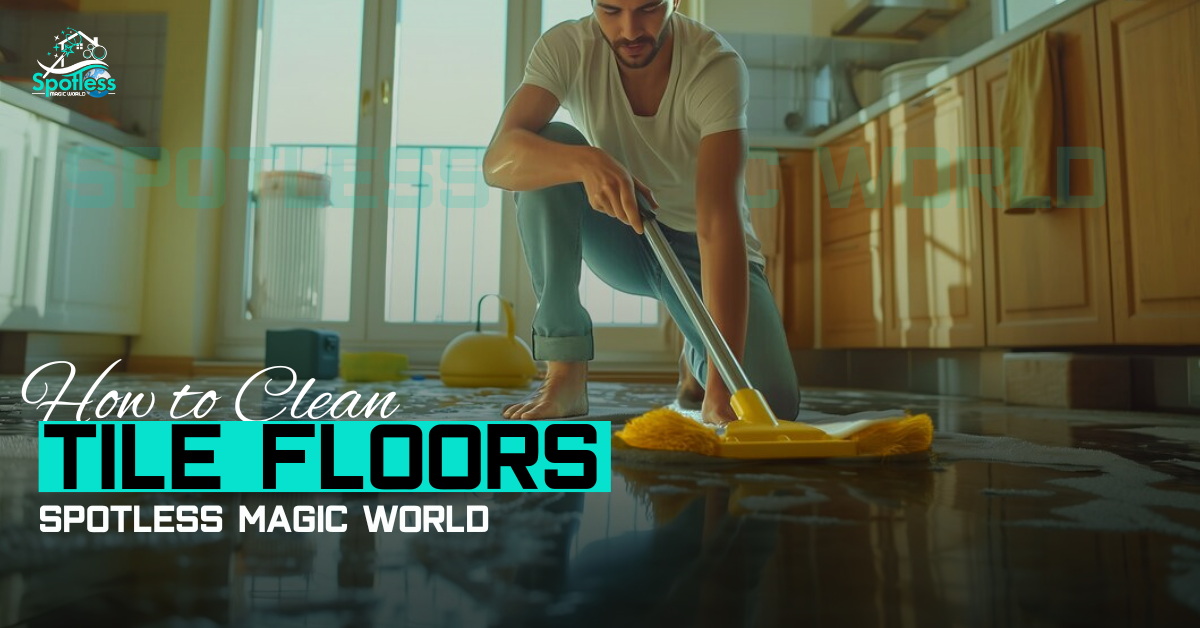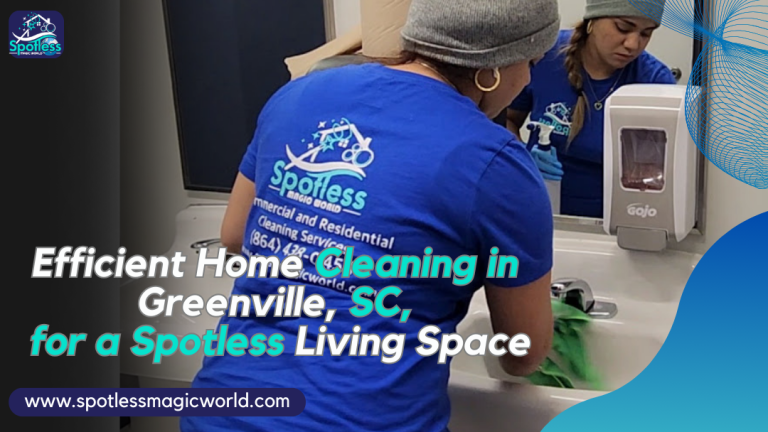Licensed And Insured

How to Clean Tile Floors | Spotless Magic World
Keeping your tile floors spotless requires more than just a regular sweep. Whether you’re dealing with ceramic, porcelain, stone, or resilient tiles, knowing how to clean tile floors effectively is key to maintaining their shine and longevity. In this guide, we’ll walk you through the best practices for tile floor cleaning, so your floors can stay looking fresh and new.
How to Clean Tile Floors| Spotless Magic World
When it comes to tile floor maintenance, it’s crucial to use the right techniques and products. Follow our expert advice to ensure your tile floors stay spotless and inviting.
How to Clean Tile Floors of All Types
Cleaning tile floors effectively requires understanding the specific needs of each tile material. Here’s a detailed guide on how to clean tile floors of various types to keep them looking their best:
General Cleaning Tips
Regardless of the tile type, start with these general cleaning steps:
- Sweep or Vacuum: Regularly sweep or vacuum your tile floors to remove loose dirt and debris. This helps prevent scratches and maintains the tile’s shine.
- Mop with Appropriate Cleaner: Use a mop and a suitable cleaning solution for your tile type. Avoid using excessive water, which can damage the tile or grout over time.
How to Clean Tile Floors Made of Ceramic and Porcelain
Ceramic and porcelain tiles are known for their durability and aesthetic appeal, making them a popular choice for both residential and commercial spaces. Cleaning ceramic tiles and porcelain properly ensures they retain their shine and longevity. Here’s a step-by-step guide on how to effectively clean ceramic and porcelain tile floors:
1. Prepare Your Cleaning Supplies
Before you start, gather the following items:
- Broom or Vacuum: To remove loose dirt and debris.
- Mop: Mopping tile floors with a microfiber mop is good for the tile
- Bucket: For mixing your cleaning solution.
- Tile Cleaner: Choose a mild, pH-balanced tile floor cleaning solutions or a solution specifically designed for ceramic and porcelain tiles.
- Clean Water: For rinsing.
- Dry Towels or Cloths: For drying the floor.
2. Sweep or Vacuum the Floor
Begin by sweeping or vacuuming the tile floor to remove loose dirt, dust, and debris. This step prevents scratching the tiles when you mop them. Ensure you get into the corners and along the edges.
3. Prepare the Cleaning Solution
Mix a cleaning solution in your bucket. If you’re using a commercial tile cleaner, follow the instructions on the label. If you prefer a DIY solution, mix a few drops of mild dish soap or a gentle pH-balanced cleaner with warm water. Avoid using bleach or harsh chemicals, as these can damage the tiles and grout.
4. Mop the Floor
Dip your mop into the cleaning solution and wring it out to remove excess liquid. Mop the floor in a figure-eight or side-to-side motion, working in small sections. This technique helps to avoid pushing dirty water around and ensures even cleaning.
- Avoid Over-Wetting: Ceramic and porcelain tiles are resistant to water, but excessive moisture can seep into the grout, potentially causing damage over time. Keep the mop damp, not soaking wet.
5. Rinse the Floor
After mopping a section, rinse the mop frequently in the bucket to avoid spreading dirty water. Once the floor is clean, rinse it with clean water to remove any soap residue. This step helps to prevent streaks and ensures a thorough cleaning.
6. Dry the Floor
After rinsing, use clean towels or clothes to dry the tile floor. Drying the floor helps prevent water spots and streaks, and it also ensures that any remaining moisture does not seep into the grout.
7. Address Stubborn Stains
For stubborn stains or grout discoloration:
- Removing stains from tile: Apply a tile-safe stain remover according to the manufacturer’s instructions.
- Baking Soda Paste: For a natural solution, mix baking soda with water to form a paste. Apply the paste to the stain, let it sit for 10-15 minutes, then scrub gently with a soft brush or cloth. Rinse thoroughly.
8. Regular Maintenance
To keep your ceramic and porcelain tiles looking their best:
- Clean Spills Promptly: Wipe up spills as soon as they occur to prevent staining.
- Regular Sweeping and Mopping: Establish a regular cleaning schedule to keep dirt and grime at bay.
- Use Doormats: Place mats at entrances to reduce the amount of dirt tracked onto your tiles.
How to Clean Tile Floors Made of Stone
Stone tiles, including marble, granite, travertine, and slate, add a touch of natural elegance to any space. However, they require specific cleaning methods to maintain their beauty and durability. Here’s a comprehensive guide on how to clean stone tile floors effectively:
1. Gather Your Cleaning Supplies
Before you start, make sure you have:
- Broom or Vacuum: To remove loose dirt and debris.
- Mop: A microfiber mop or a soft mop head.
- Bucket: For mixing cleaning solutions.
- Stone-Safe Cleaner: Use a pH-neutral cleaner specifically designed for stone.
- Clean Water: For rinsing.
- Soft Cloths or Towels: For drying.
2. Sweep or Vacuum the Floor
Begin by sweeping or vacuuming the floor to remove loose dirt and debris. This step prevents scratching the stone tiles during the mopping process. Pay special attention to corners and edges where dust can accumulate.
3. Prepare the Cleaning Solution
Stone tiles are sensitive to acidic and alkaline cleaners, which can damage their surface. Use a pH-neutral cleaner that’s designed for stone tiles. Mix the cleaner with warm water according to the manufacturer’s instructions.
- DIY Solution: If you prefer a natural cleaner, mix a few drops of mild dish soap with warm water. Ensure that the soap is pH-neutral to avoid damaging the stone.
4. Mop the Floor
Dip your mop into the cleaning solution and wring it out to remove excess moisture. Mop the floor in a gentle, overlapping pattern to ensure even coverage.
- Avoid Excessive Water: Stone tiles can absorb water, which may lead to damage or grout problems. Keep your mop damp, not soaking wet.
5. Rinse the Floor
After mopping a section, rinse the mop frequently in the bucket to avoid spreading dirty water. Once the entire floor has been cleaned, rinse the area with clean water to remove any remaining soap or cleaner residue. This step helps to prevent streaks and maintains the stone’s natural shine.
6. Dry the Floor
Use soft cloths or towels to dry the stone tile floor thoroughly. Drying the floor helps prevent water spots and streaks and reduces the risk of moisture damage.
7. Address Stubborn Stains
For stubborn stains or discolorations:
- Stone Cleaner: Apply a stone-safe cleaner designed for specific stains according to the product instructions.
- Baking Soda Paste: For a natural approach, mix baking soda with water to create a paste. Apply the paste to the stain, let it sit for 10-15 minutes, then scrub gently with a soft brush or cloth. Rinse thoroughly and dry.
8. Regular Maintenance
To keep your stone tile floors looking their best:
- Clean Spills Immediately: Stone tiles are porous and can absorb spills, leading to stains. Wipe up spills as soon as they occur.
- Regular Sweeping and Mopping: Establish a cleaning routine to prevent dirt and grime buildup.
- Use Mats and Rugs: Place mats or rugs in high-traffic areas to reduce the amount of dirt that comes into contact with your stone tiles.
9. Sealing Stone Tiles
Stone tiles often benefit from periodic sealing to protect their surface from stains and moisture:
- Choose the Right Sealer: Use a sealer designed specifically for your type of stone.
- Apply as Needed: Follow the manufacturer’s instructions for application frequency and techniques.
How to Clean Resilient Tile Floors
Resilient tile floors are durable and versatile, but they require proper cleaning to maintain their appearance and longevity. Here’s a basic guide:
Daily Cleaning:
- Sweep or mop: Remove dirt, dust, and debris daily. Use a soft broom or a mop with a clean, damp microfiber pad.
- Avoid excessive water: While damp mopping is necessary, avoid soaking the floors. Excess water can seep into the grout and cause damage.
Weekly Cleaning:
- Deep clean: Use a mild, pH-neutral floor cleaner specifically formulated for resilient tile. Follow the manufacturer’s instructions.
- Scrub stubborn stains: For tougher stains, use a soft-bristled brush or a non-abrasive cleaning pad.
Tips for Resilient Tile Floor Care:
- Protect from scratches: Use doormats at entrances to prevent dirt and grit from being tracked onto the floors.
- Avoid harsh chemicals: Avoid using harsh chemicals, such as bleach or ammonia, as they can damage the tile’s finish.
- Address spills promptly: Clean up spills immediately to prevent stains.
- Check for manufacturer’s recommendations: Always consult the manufacturer’s guidelines for specific cleaning instructions and recommended products.
How to Clean Tile Grout
Grout can become discolored, stained, and moldy over time. Here’s how to clean it effectively:
Tools and Supplies:
- Grout cleaner
- Stiff-bristled brush
- Microfiber cloth
- Bucket
- Warm water
Steps:
- Prepare the area: Clear the area around the grout to prevent damage.
- Mix the grout cleaner: Follow the instructions on the grout cleaner label to mix it with water.
- Apply the cleaner: Apply the cleaner to the grout using a stiff-bristled brush. Work in small sections.
- Scrub the grout: Scrub the grout vigorously, paying attention to any discolored or stained areas.
- Rinse the grout: Rinse the grout thoroughly with clean water. Use a microfiber cloth to remove any residue.
- Dry the grout: Allow the grout to dry completely before applying a grout sealer (optional).
Grout cleaning tips:
- For stubborn stains: Use a grout cleaner specifically designed for tough stains or mold.
- Prevent future stains: Seal the grout after cleaning to help prevent stains and mold.
- Regular maintenance: Clean the grout regularly to maintain its appearance and prevent buildup.
How Often to Clean Tile Floors
Keeping tile floors clean is essential for maintaining their appearance and longevity. The frequency of cleaning can depend on several factors, including the type of tile, the level of foot traffic, and the presence of pets or children. Here’s a detailed guide on how often to clean tile floors to keep them in optimal condition:
1. Daily Cleaning
- High-Traffic Areas: For areas with heavy foot traffic, such as entryways, kitchens, and hallways, it’s important to sweep or vacuum daily. This helps to remove loose dirt and debris that can scratch the surface of the tiles.
- Spills and Stains: Immediately clean up spills and stains to prevent them from setting into the tile or grout. Use a damp cloth or paper towel and a suitable cleaner to address any spills as soon as they occur.
2. Weekly Cleaning
- Sweeping or Vacuuming: At least once a week, sweep or vacuum your tile floors to remove accumulated dirt and debris.
- Mopping: Mop the floors weekly using a tile-friendly cleaner. For resilient tile floors like vinyl or linoleum, a mild dish soap solution can be effective. For ceramic, porcelain, or stone tiles, use a cleaner specifically designed for the tile type.
3. Monthly Cleaning
- Deep Cleaning: Perform a more thorough cleaning once a month. This includes sweeping, vacuuming, and mopping the floors. For ceramic or porcelain tiles, consider using a cleaner with a bit more strength, but still appropriate for the tile type.
- Grout Cleaning: Monthly is a good time to give grout lines extra attention. Use a grout cleaner or a homemade solution of baking soda and water to scrub grout lines and remove any buildup or discoloration.
4. Quarterly Cleaning
- Deep Scrub: Every three to four months, undertake a deep cleaning session. This might involve using a floor scrubber or a more intense cleaning solution. It’s also a good time to check for any damage or wear and tear on the grout and tiles.
- Sealing: For stone tiles, consider resealing them every three to four months to maintain their resistance to stains and moisture.
5. Annual Cleaning
- Professional Cleaning: At least once a year, consider hiring a professional cleaning service for a thorough clean. Professionals have access to specialized equipment and cleaning solutions that can effectively tackle stubborn stains, heavy grime, and restore the shine to your tiles.
- Inspection: Perform an annual inspection of your tile floors. Check for any signs of damage or issues such as cracked tiles or grout deterioration, and address these issues promptly to prevent further damage.
Factors That Affect Cleaning Frequency
- Foot Traffic: High-traffic areas will require more frequent cleaning compared to low-traffic spaces.
- Pets and Children: Homes with pets or young children may need more frequent cleaning due to additional dirt, spills, and stains.
- Environmental Conditions: In areas with a lot of dust or where outdoor elements can be tracked in, you may need to clean more often to maintain the tile’s appearance.
By adhering to these cleaning schedules and adjusting based on your specific needs, you can keep your tile floors looking clean, shiny, and well-maintained.
Spotless Magic World: Your Tile Floor Maintenance Partner
At Spotless Magic World, we understand the importance of maintaining immaculate tile floors. Our expert team provides comprehensive tile floor cleaning and maintenance services tailored to meet the unique needs of your flooring. Whether you need routine cleaning, stain removal, or specialized care for different tile types, our professionals use the best products and techniques to keep your floors looking their best.
Bottom Line
Maintaining clean tile floors is essential for creating a hygienic and visually appealing living or working environment. By following the expert advice provided in this guide, you can effectively clean tile floors of all types, ensuring they remain spotless and inviting. Remember to choose the right cleaning products, follow the recommended cleaning schedules, and address spills and stains promptly to prolong the life and beauty of your tile floors.
With proper care and attention, your tile floors will continue to be a focal point of your space for years to come.



